Toyota Camry XV30 sedan was produced from mid 2001 to 2006. It attracted buyers with its reliability, comfort, good equipment and solidity. The European consumer did not appreciate the advantages of this model, preferring it to Toyota Avensis. In North America, Japan and the CIS countries, the thirtieth has become a real bestseller. In our country, the thirtieth body, despite its solid age, is an attractive, noteworthy car until now.
Body and Appearance
The exterior is the embodiment of American car design of those years, which were characterized by smooth lines, rounded shapes and the obligatory presence of chrome on the grille. The appearance of 5th generation Camry fully complies with the philosophy of a comfortable, solid business-class car. The body compared to the previous generation (XV 20) has increased significantly in size: the length by 50 mm, height by 70 mm, and width by 10 mm.
 Camry in the 30th body is made of excellent metal: even if the whole car is covered with small chips, you are unlikely to find rust on it.
Camry in the 30th body is made of excellent metal: even if the whole car is covered with small chips, you are unlikely to find rust on it.
The only place where the "bugs" can appear is a trunk lid near the chrome trim. In 2005, the car has been slightly restyled: the grille and front bumper have been changed, other headlights and taillights are installed.
Interior of the XV 30
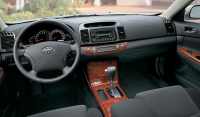 The interior space in the Camry 30 is quite enough to comfortably accommodate 5 people. The interior can be trimmed in velour or leather depending on the configuration, the materials are wear-resistant. The seats are made in American style, they are soft without obvious side support, the driver and front passenger has the ability to adjust the lumbar roll. Heated front seats and climate control will help to keep comfort in the cabin in any weather. When designing, not a little attention was paid to safety. The basic set of options included the following systems: four airbags, ISOFIX child seat mounts, third brake light, anti-blocking system (ABS), brake force distribution system (EBD), brake assist system (BAS).
The interior space in the Camry 30 is quite enough to comfortably accommodate 5 people. The interior can be trimmed in velour or leather depending on the configuration, the materials are wear-resistant. The seats are made in American style, they are soft without obvious side support, the driver and front passenger has the ability to adjust the lumbar roll. Heated front seats and climate control will help to keep comfort in the cabin in any weather. When designing, not a little attention was paid to safety. The basic set of options included the following systems: four airbags, ISOFIX child seat mounts, third brake light, anti-blocking system (ABS), brake force distribution system (EBD), brake assist system (BAS).
Engines and transmissions
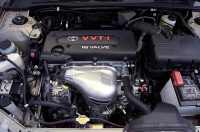 In the European market, the Toyota Camry 30 was equipped with two gasoline engines: a four-cylinder 2.4 2AZ-FE with VVT-I system on the intake and V6 3.0 1MZ-FE. In the U.S. market, it was possible to buy the car with a 3.3MZ-FE engine.
In the European market, the Toyota Camry 30 was equipped with two gasoline engines: a four-cylinder 2.4 2AZ-FE with VVT-I system on the intake and V6 3.0 1MZ-FE. In the U.S. market, it was possible to buy the car with a 3.3MZ-FE engine.
The power unit 2.4 has a chain drive timing, the chain is reliable, it will not need to be replaced before 300 thousand km. Thanks to the use of a variable valve timing system (VVT-I), the engine pulls even at low revs, which makes it pleasant to use in city conditions.
The V6 3.0's timing mechanism is driven by the belt, which needs to be replaced at least once every 150,000 km and only together with the rollers.
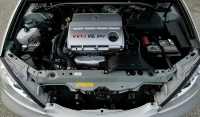 There are no questions to the reliability of power units "thirty", with correct and timely maintenance they will run 300 thousand km and more. But don't think that they won't demand attention.
There are no questions to the reliability of power units "thirty", with correct and timely maintenance they will run 300 thousand km and more. But don't think that they won't demand attention.
With poor fuel quality, the spark plugs will have to be replaced once in 20k km, moreover, the oxygen sensors will require replacement. If your engine is running flat when the spark plugs are in good condition, you'll need to clean the throttle valve.
Suspension
Creators of Toyota Camry 2002 did not try to find a compromise between drivability and comfort. They have staked on a soft power-consuming suspension, the car does not go, but floats on the road not noticing potholes and irregularities. The opposite side is body rolls even at rearrangement, not speaking about sharp turns, and nose flips at braking.
In addition to the rolls, the peculiarity of the suspension of the Camry XV 30 is its legendary reliability.
Stabilizer bushes pass at least 40 thousand km with a heavy V6 engine and more than a hundred with a four-cylinder. Ball sockets and silent blocks of front arms will serve 200 thousand.
Tail-link bushings will last 150 km, and cross-links - even longer.
Dimensions
Body dimensions: length - 4815 mm, width - 1795 mm, height - 1500 mm. Dimensions of the chassis: wheelbase - 2720 mm, minimum turning radius - 5.6 m, width of the front track - 1545 mm, width of the rear track - 1535 mm.
The volume of the fuel tank is 70 liters, trunk capacity - 473 liters.
What are the difficulties the current owner may face?
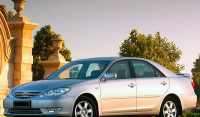 Chrome radiator grille is not durable, it does not like salt and reagents. With time, the headlights on Toyota Camry 2001-2006 produced for the U.S. market become cloudy. This problem can be solved by replacing the plastic protection with glass one from "European" thirties. Failure of electric drives of antenna and folding mirrors, cleaning mechanisms will not help for a long time.
Chrome radiator grille is not durable, it does not like salt and reagents. With time, the headlights on Toyota Camry 2001-2006 produced for the U.S. market become cloudy. This problem can be solved by replacing the plastic protection with glass one from "European" thirties. Failure of electric drives of antenna and folding mirrors, cleaning mechanisms will not help for a long time.
The power windows are often broken, the mechanism is replaced only completely. The air conditioner has been on for a while, but it's still hot - the fan, or rather its relay, has failed. Age and hard conditions of using a car will cause radiator leakage, to postpone this breakage wash radiator once a year and change antifreeze every 30 thousand km.
Front brake disks can easily become damaged when passing a puddle after hard braking, it is necessary to change them often once in 30 thousand km. Each time you change pads, clean and lubricate caliper guides, if you don't do that, they may freeze.
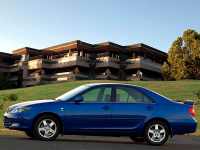

-rear-and-front-view-camera-6.png)

